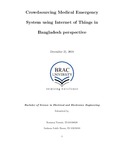| dc.contributor.advisor | Sabuj, Dr. Saifur Rahman | |
| dc.contributor.author | Yesmin, Romana | |
| dc.contributor.author | Hasan, Sadman Sakib | |
| dc.date.accessioned | 2019-05-08T08:42:57Z | |
| dc.date.available | 2019-05-08T08:42:57Z | |
| dc.date.copyright | 2018 | |
| dc.date.issued | 2018-12-25 | |
| dc.identifier.other | ID 16110028 | |
| dc.identifier.other | ID 13121018 | |
| dc.identifier.uri | http://hdl.handle.net/10361/11863 | |
| dc.description | This thesis is submitted in partial fulfilment of the requirements for the degree of Bachelor of Science in Electrical and Electronic Engineering, 2018. | en_US |
| dc.description | Cataloged from PDF version of thesis. | |
| dc.description | Includes bibliographical references( pages 57-61). | |
| dc.description.abstract | Bangladesh is a developing country with huge population in this small territory.
In population census 2011, we knew that our 7.48% populations are aged above
60 years of age. Also most of our people are unaware of the system that provide
real and practical health care provided by government and non-government care
givers at the remote areas, we propose a system that will make easy for them to
use and get the medical help everywhere in our country timely. In this modern era
many things are going to be model with the latest technologies achieved. By this
time most of us have mobile/cell phones under operation. So if we can establish a
system that the mobile phone may be the e ective tool to rescue people in medical
emergencies will be very helpful in countries like ours as well as the under developing
countries. The aim of this research work is to design a medical emergency system by
leveraging the concept of crowd sourcing that will be able to (1) Monitor and detect
a medical emergency situation and (2) Minimize the emergency response time and
operational cost. This proposed `Neighbour Assisted Medical Emergency System
(NAMES)' will use the voluntary participation of the neighbours. In this system
during an emergency situation, it will connect the cloud and it will search for the
nearest neighbour to connect for helps and solutions. Then cloud will give the details
to neighbour. After accepting the request, the neighbour will be equipped with the all necessary documents shortest possible time limit. According to decision of
the neighbour, the pharmacy or ambulance will be contacted through neighbour.
If ambulance required it will connect to the GPS for transportation and by the
ambulance the patient has to reach to the hospital for treatment. This emergency
describes by rapid response system should improve the medical emergency needs as
a whole. There must be some main components (i) Event detection and response
triggering (ii) Crisis response (iii) Process improvement through feedback and (iv)
Governance and administration. Based on all these components, it is essential for
a neighbour to get the information about the subscribers sooner and be responsible
to give the support to the subscribers which will de nitely help the human mankind
ultimately. | en_US |
| dc.description.statementofresponsibility | Romana Yesmin | |
| dc.description.statementofresponsibility | Sadman Sakib Hasan | |
| dc.format.extent | 61 pages | |
| dc.language.iso | en | en_US |
| dc.publisher | Brac University | en_US |
| dc.rights | Brac University theses are protected by copyright. They may be viewed from this source for any purpose, but reproduction or distribution in any format is prohibited without written permission. | |
| dc.subject | IoT | en_US |
| dc.subject | Crowdsourcing | en_US |
| dc.subject | Medical emergency system | en_US |
| dc.subject.lcsh | Crowdsourcing. | |
| dc.subject.lcsh | Emergency medical services--Bangladesh. | |
| dc.title | Crowdsourcing medical emergency system using Internet of things in Bangladesh perspective | en_US |
| dc.type | Thesis | en_US |
| dc.contributor.department | Department of Electrical and Electronic Engineering, Brac University | |
| dc.description.degree | B. Electrical and Electronic Engineering | |

